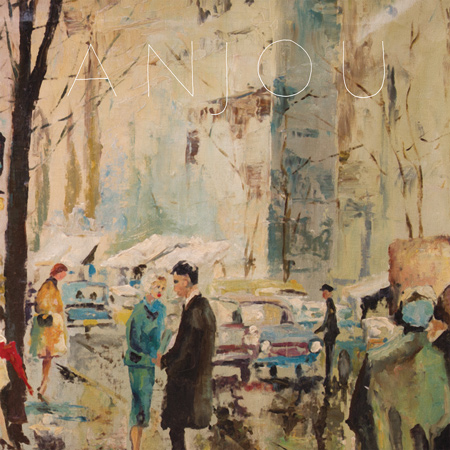 All art, whether by design or by accident, contends with time. But music’s relationship to it, like cinema’s, is pronounced, as is evident in the case of Anjou. On their Kranky debut, ex-Labradford members Mark Nelson and Robert Donne join Haptic’s (and Innode’s and Pan•American’s) Steven Hess for eight melancholy preludes focused on form, color, light, and time. Their songs are short, no longer than nine minutes, and expressionistic, dotted with half-heard rhythms and implied melodies orbiting a tonal center. They issue into the room in suspended animation and hang there mysteriously, heavy like a storm cloud. In them, the passage of time ceases to mark minutes and seconds and instead denotes the availability of different perspectives. Sounds are typically thought of as moving through spaces, but in this case spaces move through sounds, guided in their course by a trio of directors with an impossible view from above.
All art, whether by design or by accident, contends with time. But music’s relationship to it, like cinema’s, is pronounced, as is evident in the case of Anjou. On their Kranky debut, ex-Labradford members Mark Nelson and Robert Donne join Haptic’s (and Innode’s and Pan•American’s) Steven Hess for eight melancholy preludes focused on form, color, light, and time. Their songs are short, no longer than nine minutes, and expressionistic, dotted with half-heard rhythms and implied melodies orbiting a tonal center. They issue into the room in suspended animation and hang there mysteriously, heavy like a storm cloud. In them, the passage of time ceases to mark minutes and seconds and instead denotes the availability of different perspectives. Sounds are typically thought of as moving through spaces, but in this case spaces move through sounds, guided in their course by a trio of directors with an impossible view from above.
When it comes to melody, Anjou is all dark, thickly applied colors. It makes more sense to talk about the album’s latent melodies actually, as many of its songs, like "Lamptest" and "Readings," begin and end in nearly the same place with minimal development happening in between. They don’t move along linearly, from left to right, they vibrate in place or hum from top to bottom, congealing ultimately as textures, not as melodic lines. What distinct melodies there are generally fall by the wayside, usurped by stereoscopic radiation that bleeds out into fields of deep red, blue, and purple, all reverberating on an imposing black canvas.
A sense of darkness and of concealment permeates the entire album, from the structural level down to the instrumental, where fragmented or otherwise murky sediment constantly works to disguise the music’s formal features. The structure of each song is easy enough to spot. There is the looped synthesizer, the guitar feeding back on itself, the electronic drums beating softly in the background, static interference, live percussion, and sudden, solitary chords that open up in the noise like valleys opening up in the mountains. These are repeated, subdued, emphasized, distended, or otherwise modified in different ways, just enough to create a sense of movement, a sense that something is about to take shape. What that is never becomes clear, however. The shapes turn to shadows, the shadows to blurry movements, and the movements themselves to doubtful illusions.
The song titles all point in this direction either directly or obliquely: "Lamptest" and "Backsight" in the sense of shining a light on things and peeling back the dark, or at least trying to; "Readings" and "Adjustment" in the sense of interpreting something unclear; and "Sighting" and "Inclosed" in the sense of what can and can’t be seen, no matter how hard one looks. Because Anjou is so strongly visual —and because it is so effective at focusing the ear on a place where melody, rhythm, and texture meet— time is frozen and highlighted, made conspicuous in its subordination to space, color, and light. These songs don’t unfurl, they shift focus, as if a camera were recording them by moving up and down the length and width of a musical object. What we hear is just a small section of some endless unknown thing vibrating out in all directions. In this way time is made equal to space. It becomes an extra dimension and not just a series of hash marks reminding us that something was here once, but is now gone. Music has always made time available to the ears. On Anjou, Nelson, Donne, and Hess transpose it for the eyes.
samples:
 
Read More

